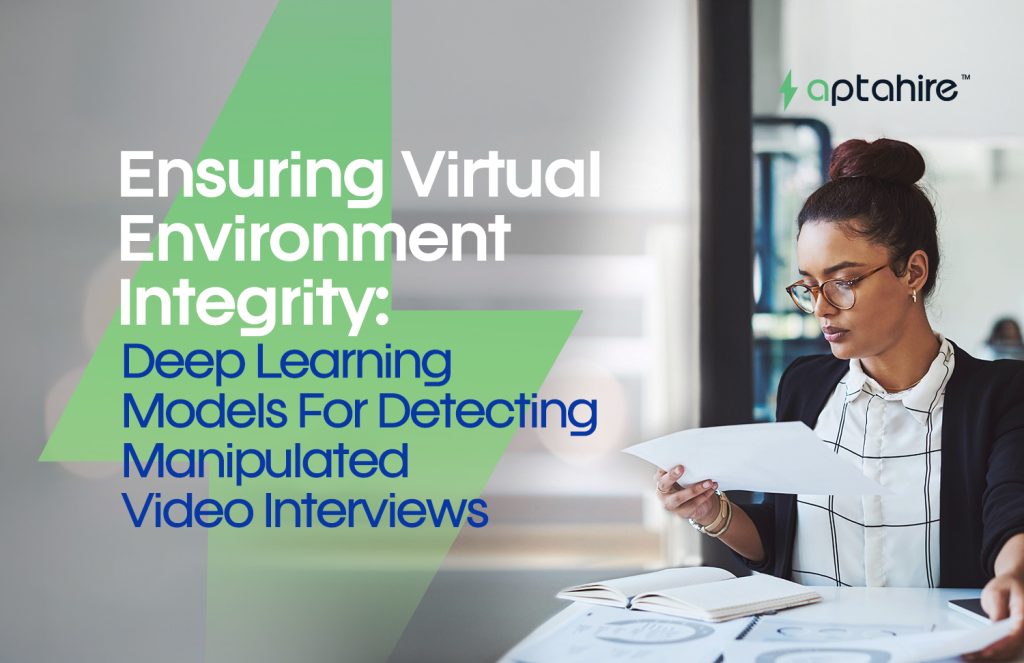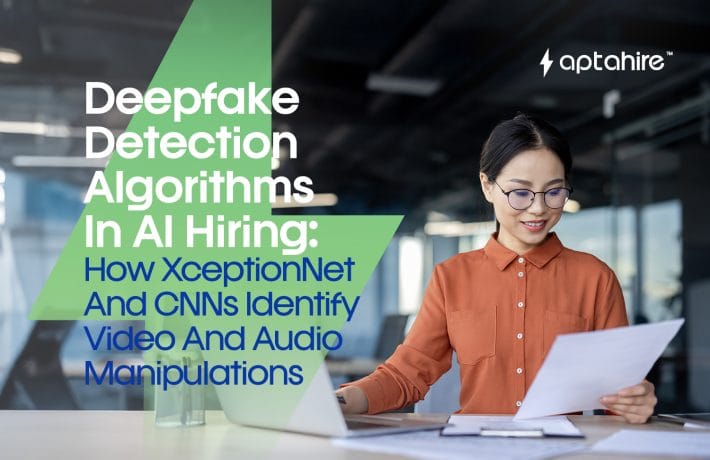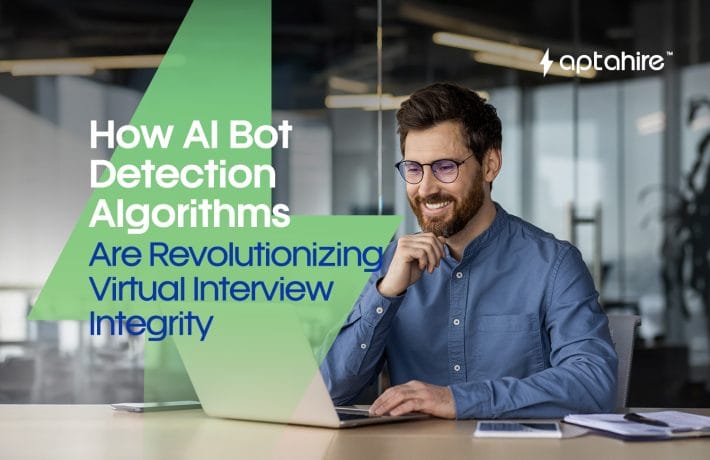Ensuring Virtual Environment Integrity: Deep Learning Models for Detecting Manipulated Video Interviews

The Great Shift: From Office Desks to Laptop Screens
Hiring today doesn’t look like it did even five years ago. No traffic jams to attend an interview. No formal wear from head to toe, just the upper half, maybe. And no conference rooms filled with interview panels. Instead, we now see grids of faces on screens, from candidates logging in from their bedrooms, balconies, or cafés halfway across the world.
Virtual interviews have revolutionized recruitment. They’ve made it faster, borderless, and more efficient. Companies can now screen hundreds of applicants without leaving their chairs. It’s the future. But with this convenience comes a silent threat: the rise of manipulated video interviews.
As hiring becomes digital, authenticity becomes the new currency, and companies must now verify not only what candidates say, but whether it’s even them saying it.
Manipulated Video Interviews: Not a Scene from Black Mirror
Let’s get specific. What is a manipulated video interview?
It’s when a candidate uses deceptive technologies or tricks to misrepresent themselves during a virtual hiring process. That includes:
- Pre-recorded videos pretending to be live answers
- Deepfakes that use AI to mimic someone’s face and voice
- Face-swapping filters to match someone else’s appearance
- Lip-syncing or dubbed audio to sound smarter, clearer, or like someone else
- Proxy interviews—when another person sits in for the real candidate
These manipulations are real, increasingly sophisticated, and shockingly accessible.
There are even Telegram groups, YouTube tutorials, and freelance marketplaces offering “video interview proxy services” for a fee. It’s no longer limited to hackers or cybercriminals, anyone with a little tech curiosity and desperation can try to game the system.
Why Should Companies Care?
Here’s why this should be at the top of every recruiter and HR leader’s radar:
- Wrong Hires = Real Costs
A single bad hire can cost a company up to 30% of that employee’s annual salary, according to the U.S. Department of Labor. Imagine hiring someone who literally wasn’t even at their interview.
- Risk of Security Breaches
Especially in roles that involve sensitive data, finance, health records, or access to critical systems, hiring the wrong person isn’t just unproductive, it’s dangerous.
- Reputation Damage
Clients, investors, and future employees notice. If word spreads that your company hires inauthentic candidates, trust goes out the window.
- Legal and Compliance Fallout
In industries like banking, pharma, and public sector recruitment, identity verification and due diligence are legal requirements. Hiring through manipulation can open up serious compliance violations.
Deep Learning: The Silent Guardian of Virtual Interviews
Now here’s where it gets exciting.
Deep learning, a powerful subfield of artificial intelligence, is emerging as the most robust way to detect manipulated interviews. It mimics how the human brain works, learning from patterns, making predictions, and improving over time.
Deep learning models don’t just detect obvious signs of cheating; they can identify micro-level irregularities that no human could catch.
Let’s go step by step into how these models protect interview integrity.
How Deep Learning Works in the Context of Video Interviews
1. Visual Authenticity Check: Is This a Real Face or a Fake One?
Deep learning models use Convolutional Neural Networks (CNNs) to analyze each frame of a video:
- Are the skin textures consistent with natural human pores?
- Are the eye blinks irregular or robotic?
- Do the shadows behave naturally around facial contours?
- Is the person too smooth, indicating CGI or deepfake overlay?
It’s like having a visual lie detector, watching every micro-expression to judge authenticity.
2. Liveness Detection: Is the Candidate Actually There Right Now?
This is a big one. Liveness detection uses a combination of:
- Depth estimation: Real faces have depth; videos do not.
- Motion tracking: Natural head tilts, slight twitches, and unconscious muscle movements.
- Light reflection analysis: Light hits skin differently compared to a screen or video projection.
In short, the AI checks if the candidate is a living, breathing person, or just a replayed image on a screen.
3. Audio-Video Sync Detection: Does the Voice Match the Lips?
Lip-syncing and dubbed videos can be subtle, but deep learning is better than the human eye.
It uses Temporal Convolutional Networks to map the movement of lips with the sound being heard:
- Are syllables aligning with lip shape?
- Is there a fraction-of-a-second delay consistently across the video?
- Is the voice natural, or synthetic/AI-generated?
Even small mismatches can be detected and flagged.
4. Behavioral Biometrics: Does This Person Act Like Themselves?
Here’s where it gets next-level.
Deep learning also tracks biometric behavior:
- Typing patterns
- Mouse movement trajectories
- Eye tracking
- Facial gestures unique to an individual
If a candidate shows different patterns across different sessions, say, Round 1 and Round 2—it might indicate someone else has stepped in. These insights are deeply personal and difficult to fake, making them excellent markers of integrity.
5. Environmental Consistency: Is the Background Real or Static?
Remember those people who use fake virtual Zoom backgrounds?
Deep learning models analyze backgrounds for:
- Static pixel patterns (repeating textures or loops)
- Lighting mismatches between face and background
- Shadow discrepancies (face has shadows, background doesn’t)
Even fake green-screen tricks can’t hide from models trained to analyze environmental depth and light physics.
Real-World Use Cases: This Isn’t Just Theory
🔹 HireVue, Talview, Aptahire
These platforms already use deep learning-based integrity models to prevent cheating, flag inconsistencies, and score candidate authenticity.
🔹 Global Financial Institutions
In fraud-heavy hiring zones, deep learning is used to cross-check every candidate’s audio signature and facial metrics with prior rounds.
🔹 Public Sector Exams
Governments in India, the U.S., and Europe are using deep learning for secure proctoring and interview monitoring to prevent proxy test-takers.
The Ethics of AI-Powered Surveillance in Hiring
This is powerful tech, but it must be wielded ethically.
Companies should ensure:
- Transparent candidate consent: Let them know AI is being used
- Data security: No storing sensitive biometrics longer than needed
- Bias mitigation: Ensure diverse datasets to avoid racial or gender-based errors
- Human oversight: AI should support, not replace, human judgment
The goal isn’t to police candidates, but to protect genuine ones from being unfairly outcompeted by cheaters.
The Challenges of AI-Driven Integrity Detection
Even with all its brilliance, deep learning isn’t foolproof.
- False alarms can occur due to network lag or poor lighting
- Smart fraudsters may find new ways to trick systems
- Heavy computation is required to analyze real-time interviews
- Legal implications exist around surveillance and data handling
But as the tech improves and ethical frameworks evolve, the balance is shifting in favor of authentic, fair hiring.
What’s Next? The Future of Deep Learning in Hiring
- Live candidate verification scorecards
- Instant fraud detection alerts during interviews
- Immutable interview records via blockchain
- Voiceprint authentication combined with face recognition
- AI watchdogs for mass hiring campaigns in real time
In short, a future where trust is not just assumed, it’s algorithmically validated.
Conclusion: Trust is the New Interview Currency
As hiring continues to go virtual, deep learning will be the firewall between authenticity and deceit.
Candidates who work hard and prepare deserve to be evaluated fairly, not to lose out to someone cheating with a deepfake or proxy.
For recruiters, deep learning offers clarity, confidence, and control. It makes sure that the candidate you’re hiring is who they say they are, not just who they appear to be.
We’re entering an era where AI doesn’t just filter resumes, it protects integrity, defends fairness, and upholds the soul of hiring.
FAQs
1. What is a manipulated video interview?
A manipulated video interview refers to any virtual interview where the candidate uses deceptive techniques to misrepresent their identity or responses. This includes tactics like deepfake technology, pre-recorded videos, face-swapping filters, lip-syncing, or having another person attend the interview on their behalf.
2. How can deep learning detect if a candidate is using a deepfake or pre-recorded video?
Deep learning models analyze various visual and behavioral cues such as facial micro-expressions, inconsistent blinking, unnatural lighting and shadows, frame stuttering, and lack of depth. These subtle anomalies help the system determine whether the candidate on-screen is real, live, and authentic.
3. What is liveness detection in virtual interviews?
Liveness detection is a technique used to ensure that the person on video is physically present and interacting in real-time. It uses indicators like spontaneous head movement, natural blinking, shifting gaze, and dynamic lighting response to confirm that the video feed is not a static image or replayed video.
4. Can audio manipulation be detected during a virtual interview?
Yes. Deep learning models compare lip movements with the audio to check for sync accuracy. If there’s a delay or mismatch, often seen in dubbed or lip-synced videos, the system flags it. Voice consistency and natural speech patterns are also analyzed to detect voice modulation or synthetic audio.
5. What behavioral signals does AI use to verify candidate authenticity?
AI tracks a range of biometric behaviors, including typing rhythm, mouse movements, eye movement patterns, facial gestures, and reaction times. If these patterns shift significantly across sessions, it could indicate that the person appearing in the interview is not the same as before.
6. Is using AI to monitor interviews ethical and legal?
Yes, but it must be done with clear consent and transparency. Employers must inform candidates that AI is being used to verify their presence and behavior. Data privacy, fairness, and bias mitigation are also essential to ensure ethical usage of such technologies.
7. Can AI make mistakes or flag genuine candidates as suspicious?
Like any technology, AI isn’t flawless. Poor lighting, low internet bandwidth, or outdated webcams can sometimes cause false positives. That’s why it’s recommended to use AI as a supporting tool, with human recruiters making the final decision after reviewing the flagged instances.
8. What industries benefit the most from deep learning-based interview integrity checks?
Industries like IT, finance, healthcare, education, public sector, and cybersecurity benefit greatly, especially when hiring remote workers or filling sensitive roles. These sectors require high-trust hiring environments and cannot afford to onboard fraudulent or unverified candidates.


